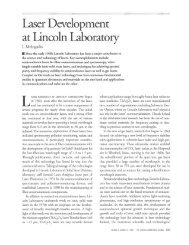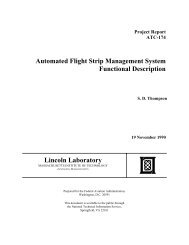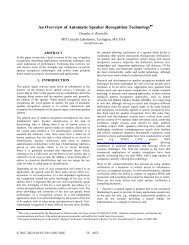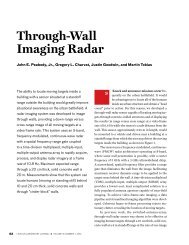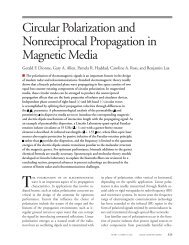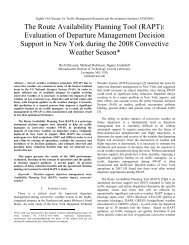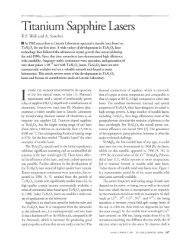2011 Annual Report - MIT Lincoln Laboratory
2011 Annual Report - MIT Lincoln Laboratory
2011 Annual Report - MIT Lincoln Laboratory
You also want an ePaper? Increase the reach of your titles
YUMPU automatically turns print PDFs into web optimized ePapers that Google loves.
LEADERSHIP<br />
Sensor window for<br />
3D ladar inside aircraft<br />
Dr. Robert T-I. Shin Dr. Robert G. Atkins Mr. Robert A. Bond Dr. Curtis W. Davis III Dr. James Ward Dr. William D. Ross<br />
sensor data. This work includes advanced<br />
moving target tracking algorithms, machine<br />
learning of vehicle behavior patterns, and<br />
automated detection of anomalous activity.<br />
This activity-based analytics software<br />
was shown to be useful in increasing the<br />
throughput of ISR analysts. The initial<br />
version was transitioned to government<br />
users, and research is continuing.<br />
■ The <strong>Laboratory</strong> developed and tested<br />
an adaptive-data-rate, medium-range<br />
(100 m–1 km) RF data link that supports<br />
data rates from 1 Mb/s up to 1.9 Gb/s.<br />
This system uses advanced multiple-input,<br />
multiple-output techniques and very-highperformance<br />
adaptive space-time coding.<br />
The system sets new standards for non-lineof-sight,<br />
low-power communication links<br />
and enables efficient data exchange among<br />
ground-based distributed ISR systems.<br />
Height (m)<br />
30<br />
21<br />
12<br />
The 3D imagery of the Space Shuttle Explorer at the Kennedy Space Center complex in Florida was created from<br />
data acquired by the Airborne Ladar Imaging Research Testbed (ALIRT) system, shown at left.<br />
FUTURE OUTLOOK<br />
■ Increasing national investment is expected for developing and fielding improved<br />
systems for irregular and conventional warfare. As next-generation, wide-area, highresolution<br />
sensors proliferate, additional emphasis will be on improved architectures<br />
for processing, exploitation, and dissemination. The ISR program is expected to<br />
continue to develop automated exploitation techniques and data-mining software<br />
tools for single- and multi-source ISR data. The <strong>Laboratory</strong> anticipates research and<br />
development to address difficult target sets for which improved sensing capabilities<br />
are needed: individuals in urban areas, targets under foliage, quiet submarines under<br />
the sea, and deeply buried facilities.<br />
■ There will be increased opportunity for synergy between the ISR Systems and<br />
Technology and the Cyber Security mission areas. Many ISR data exploitation<br />
techniques for threat network detection, as well as their required high-performance<br />
computing technologies, have direct application to cyber security problems such as<br />
cyber situational awareness. As the computing capability of smartphones and the<br />
wireless networking of laptop computers evolve, the ISR Systems and Technology<br />
mission will need to develop advanced capabilities to keep pace with this evolution.<br />
<strong>MIT</strong> <strong>Lincoln</strong> <strong>Laboratory</strong> 35



